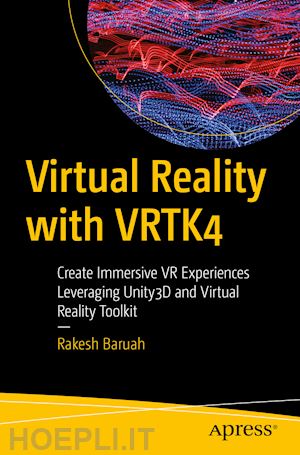
Questo prodotto usufruisce delle SPEDIZIONI GRATIS
selezionando l'opzione Corriere Veloce in fase di ordine.
Pagabile anche con Carta della cultura giovani e del merito, 18App Bonus Cultura e Carta del Docente
From game design to education to healthcare to human resources, virtual reality offers new and creative ways to engage users, students, patients, customers, and more. Not a coding book, Virtual Reality with VRTK4 shows that you don't need to be a computer or graphics whiz to begin creating your own virtual reality experiences.
What You'll Learn
Who This Book Is For
Creative professionals or students who are familiar with computer design programs and want to begin prototyping their own original virtual reality work as quickly as possible.
Chapter Goal: To introduce the reader to the broad field of computer vision.
Sub -Topics
1. Explanation and examples of spatial computing
2. Overview of principals of spatial computer from self-driving cars to AR
3. Understanding spatial computing for someone who doesn’t know physics
Chapter 2: What is Virtual Reality Toolkit?
Chapter Goal: To demonstrate how Virtual Reality Toolkit (VRTK) simplifies the science of spatial computing.
Sub - Topics
1. A brief history of VRTK framework
2. Why is VRTK useful?
3. Overview of how VRTK works.
4. What readers can hope to accomplish with only VRTK.
Chapter 3: Fundamentals of Virtual Reality Design in Unity
Chapter Goal: To jump-start the fun of making things with a crash-course into the fundamental building blocks of Unity.Sub - Topics:
1. What is Unity?
2. I’m not interested in making games, why would I use a game engine?
3. Unity creates 2D, 3D, AR, VR, and mobile content? That’s too much to learn!
4. What are the fundamentals of Unity?
Chapter 4: Creating a ‘Camera’ in VRTK
Chapter Goal: To become comfortable with VRTK by first playing with and understanding the principles of ‘camera’ transform.
Sub - Topics:
1. What is a ‘camera’ in VR?
2. What if I don’t have a head-mounted display like the Oculus Rift?
3. Overview of the physics of a VR camera
4. Exercise: setting up a VR camera with both the VRTK ‘virtual camera’ and the Oculus SDK
Chapter 5: Doing Things in Virtual Reality
Chapter Goal: Empower the reader with the understanding of how to incorporate interactivity and user input into a VR scene with VRTK.
Sub - Topics:
1. Introduction to VRTK’s ‘actions’.
2. Exercise: Putting a ‘button’ in your VR scene.
3. Exercise: ‘Chaining’ user actions
4. Exercise: Converting complex math into ‘on/off’ actions
Chapter 6: Using Gestures in Virtual Reality
Chapter Goal: To build on user input and communicate the creation pipeline from body movement to digital representation.
Sub - Topics:
1. An introduction to ‘pointers’ in VRTK
2. An explanation of the types of pointers in VRTK
3. Exercise: Step-by-step instructions for implementing pointers in a VRTK scene
Chapter 7: Getting Around in Virtual Reality
Chapter Goal: To expand readers’ understanding of virtual reality (VR) as immersive by connecting interactivity with motion in VRTK
Sub - Topics:
1. Overview of different kinds of motion embraced in VR design
2. Overview of how different headsets impact user movement and VR design
3. An important conversation on motion sickness and the design practices to avoid it in your users
4. Exercise: How to use VRTK’s ‘teleport’ feature in your own VR design
Chapter 8: Making Virtual Reality Interactive
Chapter Goal: To clearly communicate the role of ‘physics’ in Unity by walking the reader through the creation of colliders and interactables.
Sub - Topics:
1. Introduction to ‘interactor’ and ‘interactables’ in VRTK
2. Overview of Unity terms ‘rigidbody’ and ‘kinematics’
3. Exercise: How to use VRTK’s ‘teleport’ feature in your own VR design
Chapter 9: Sharing Your Experience
Chapter Goal: To cover the workflow of moving a VR scene from VRTK in Unity through examples covering webVR, Google Cardboard, and Oculus.
Sub-Topics:
1. Porting a VRTK scene from Unity to a stand-alone device
2. Sharing a VRTK scene online
3. Exercise: Publishing your work on GitHub
Chapter 10: (BONUS) Oculus Integration w/VRTK
Chapter Goal: To cover the integration of the Oculus SDK with VRTK in enough detail so the user has hands-on experience with the setup procedure for at least one head-mounted display.
Sub-Topics:
1. Because of the different types of headsets currently available and the myriad designs to follow










Il sito utilizza cookie ed altri strumenti di tracciamento che raccolgono informazioni dal dispositivo dell’utente. Oltre ai cookie tecnici ed analitici aggregati, strettamente necessari per il funzionamento di questo sito web, previo consenso dell’utente possono essere installati cookie di profilazione e marketing e cookie dei social media. Cliccando su “Accetto tutti i cookie” saranno attivate tutte le categorie di cookie. Per accettare solo deterninate categorie di cookie, cliccare invece su “Impostazioni cookie”. Chiudendo il banner o continuando a navigare saranno installati solo cookie tecnici. Per maggiori dettagli, consultare la Cookie Policy.